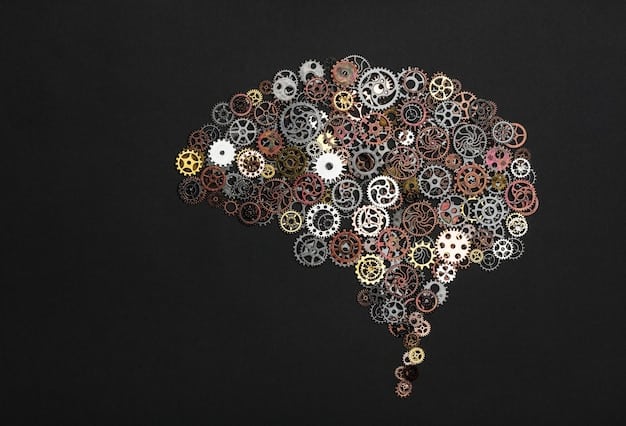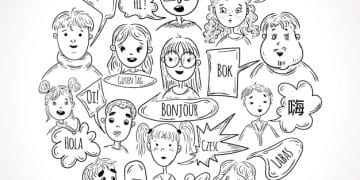Cognitive Dissonance: Justifying Beliefs Against Evidence

Cognitive dissonance describes the psychological discomfort felt when holding conflicting beliefs, values, or attitudes, leading individuals to justify their existing views even in the face of contradictory evidence to reduce this internal tension.
Ever wonder why people cling to their beliefs, even when presented with undeniable facts that contradict them? Understanding cognitive dissonance: how do people justify their beliefs in the face of contradictory evidence? delves into this intriguing psychological phenomenon, revealing the deep-seated mechanisms by which our minds strive for consistency and comfort. This exploration sheds light on everything from personal choices to societal behaviors, offering a fresh perspective on human decision-making and resistance to change, inviting you to rethink why we believe what we believe.
The Foundations of Cognitive Dissonance Theory
At its core, cognitive dissonance is a powerful psychological theory developed by Leon Festinger in the 1950s. It posits that when an individual simultaneously holds two or more conflicting cognitions—ideas, beliefs, values, or emotional reactions—they experience a state of psychological discomfort. This discomfort, or “dissonance,” motivates them to reduce it, often by changing one or more of the conflicting cognitions, adding new ones, or altering the perceived importance of the cognitions involved. It’s a fundamental drive for internal consistency that shapes much of our thought and behavior.
The theory gained significant traction through now-classic experiments, including Festinger’s own study on a doomsday cult, where members, after their prophecy failed, rationalized the non-event by claiming their faith had saved the world. This demonstrated how deeply ingrained beliefs could be reinforced, rather than abandoned, even in the face of direct empirical contradiction. These early studies laid the groundwork for understanding the complex interplay between our thoughts and actions.
Key Principles of Dissonance
- Magnitude of Dissonance: The level of discomfort experienced is directly proportional to the importance of the cognitions involved and the degree of inconsistency between them. More important beliefs, when contradicted, lead to greater dissonance.
- Routes to Reduction: Individuals can reduce dissonance by changing their behavior, changing their beliefs, or adding new cognitions to bridge the gap between conflicting elements. Each route serves the ultimate goal of psychological equilibrium.
- Inevitability of Dissonance: In a world filled with complex choices and imperfect information, experiencing cognitive dissonance is an unavoidable part of the human condition. It’s not a sign of flawed thinking, but rather a natural mechanism at play continually.
Understanding these foundational principles is crucial for grasping how cognitive dissonance operates in our daily lives. It’s not just an academic concept; it’s a living force that influences everything from our purchasing habits to our political affiliations, quietly guiding our perceptions and justifications.
Mechanisms for Resolving Cognitive Dissonance
When faced with the uncomfortable tug of conflicting thoughts or actions, our minds employ a range of ingenious, sometimes subtle, strategies to alleviate this psychological strain. These mechanisms are largely unconscious, serving to protect our self-concept and maintain a coherent worldview. From dismissing inconvenient truths to selectively interpreting data, human brains are remarkably adept at restoring internal harmony.
One of the most common ways to resolve dissonance is by changing one of the conflicting cognitions. This could mean altering a belief, attitude, or even behavior. For example, if someone believes smoking is bad but continues to smoke, they might reduce dissonance by quitting (changing behavior) or by convincing themselves that the health risks are exaggerated (changing belief). The path chosen often depends on which cognition is easier to modify or which provides the least resistance.

Common Dissonance Reduction Strategies
- Changing Beliefs: This is perhaps the most direct way. If evidence contradicts a cherished belief, one might simply adapt the belief to align with the new information. However, this is often difficult, especially for deeply held convictions.
- Changing Behavior: Altering an action to match a belief is another straightforward approach. If you believe in environmental conservation but waste resources, you might start recycling more diligently to reduce the dissonance.
- Adding New Cognitions: This involves finding new information or justifications that support one’s existing belief or behavior, thereby reducing the perceived conflict. For instance, a person eating unhealthy food might justify it by saying, “Life is short, I deserve to enjoy it.”
Another powerful mechanism is the concept of selective exposure, where individuals seek out information that supports their existing beliefs and avoid information that contradicts them. This leads to echo chambers and filter bubbles, particularly prevalent in the age of digital media. Furthermore, trivialization allows individuals to reduce the importance of dissonant cognitions, effectively downplaying the conflict by telling themselves it doesn’t really matter. These varied strategies highlight the dynamic nature of our internal cognitive battleground.
The Role of Self-Justification and Rationalization
Self-justification and rationalization are twin pillars in the architecture of cognitive dissonance reduction. When confronted with evidence that challenges our actions, beliefs, or even our very identity, our minds instinctively scramble to create narratives that paint us in a coherent and positive light. This isn’t necessarily a conscious act of deception; rather, it’s a deeply ingrained psychological process designed to alleviate discomfort and protect our self-esteem. We seek to present ourselves, both to others and to ourselves, as rational, moral, and consistent individuals.
Rationalization often involves constructing a plausible, albeit not entirely truthful, explanation for our behavior or beliefs. For example, someone who buys an expensive item they don’t truly need might rationalize the purchase by focusing on its supposed “long-term value” or “quality investment,” even if these claims are tenuous. This isn’t about lying, but about finding a comfortable story that helps us make sense of our choices and reduces the internal conflict.
How We Build Our Own Realities
- Exaggerating Positives/Minimizing Negatives: To justify a decision, we often amplify the good aspects and downplay the bad ones. After a difficult choice, the chosen option looks better, and the rejected one looks worse.
- Creating New Justifications: Sometimes, we invent entirely new reasons or beliefs to support our actions or to bridge the gap between conflicting ideas. These new cognitions help fill the logical void.
- Blaming External Factors: Shifting blame away from oneself to external circumstances or other people is a powerful way to justify failures or poor choices without damaging one’s self-concept.
The process of self-justification is particularly evident after making significant decisions. Once a choice is made, especially if it involved considerable effort or sacrifice, we tend to enhance the attractiveness of the chosen alternative and degrade the unchosen ones. This “post-decisional dissonance” ensures that we feel good about our decisions, even if they were flawed, preventing regret and maintaining psychological comfort. It’s a testament to the mind’s incredible capacity for creating its own reality.
Cognitive Dissonance in Everyday Life and Society
The principles of cognitive dissonance are not confined to laboratory experiments or academic papers; they permeate our daily existence, influencing decisions both trivial and profound. From consumer choices to political polarization, understanding this phenomenon provides a critical lens through which to observe and interpret human behavior. It explains why we might loyalty stick with a flawed product, defend an unpopular political stance, or continue a less-than-ideal relationship.
In consumer behavior, for instance, post-purchase dissonance is common. After buying an expensive car, house, or technological gadget, people often seek out information that confirms their decision was sound, while ignoring criticisms. This is why car dealerships or real estate agents might send congratulatory messages or follow-up calls after a sale; it helps reinforce the buyer’s decision and reduces potential regret. This reinforcement solidifies the bond between buyer and product, or buyer and brand, even if initial doubts were present.
Societal Manifestations
- Political Polarization: Individuals selectively consume media and engage with like-minded peers, reinforcing existing political beliefs and dismissing contradictory evidence as biased or false.
- Cult Adherence: As seen in Festinger’s original studies, cult members often intensify their beliefs after prophecies fail, justifying the discrepancy rather than abandoning their faith.
- Public Health Compliance: People might ignore or rationalize health warnings if they conflict with habits they enjoy, such as smoking or unhealthy eating, to reduce the dissonance between knowledge and behavior.
On a broader societal scale, cognitive dissonance can contribute to the persistence of harmful stereotypes or discriminatory practices. When faced with evidence that challenges preconceived notions about a group, individuals might rationalize their biases to avoid the discomfort of changing their deeply held beliefs. This resistance to change, fueled by the need for cognitive consistency, makes tackling societal issues particularly complex, highlighting the psychological barriers that often precede meaningful progress.

Cognitive Dissonance and Confirmation Bias
While distinct concepts, cognitive dissonance and confirmation bias are intimately related and often work in tandem, creating a formidable barrier to objective reasoning. Confirmation bias refers to our innate tendency to search for, interpret, favor, and recall information in a way that confirms our pre-existing beliefs or hypotheses. It’s a filtration system that actively seeks out what we already expect to find. When cognitive dissonance arises, confirmation bias often steps in as a primary reduction strategy, allowing us to maintain our internal consistency without having to confront uncomfortable truths.
Imagine someone who firmly believes a certain conspiracy theory. When presented with debunking evidence, cognitive dissonance might kick in. To alleviate this discomfort, they might employ confirmation bias, actively dismissing the evidence as part of the conspiracy or seeking out alternative “facts” online that reinforce their existing theory. This dynamic creates a self-perpetuating cycle where beliefs become more entrenched, and the individual becomes increasingly resistant to contradictory information, further cementing their worldview.
The Interplay of Bias and Dissonance
- Selective Information Seeking: Individuals actively seek sources that support their views, filtering out opposing perspectives. This lessens the likelihood of encountering dissonance-inducing content.
- Biased Interpretation: Neutral or even contradictory information is interpreted in a way that aligns with existing beliefs, minimizing its challenging impact.
- Memory Distortion: We are more likely to remember information that confirms our beliefs and forget or downplay information that challenges them, creating a fabricated sense of consistent evidence over time.
This powerful duo explains why certain beliefs, once formed, can be incredibly difficult to dislodge, even for highly intelligent individuals. It’s not a failure of logic, but rather a robust psychological defense mechanism at play. Understanding the symbiotic relationship between cognitive dissonance and confirmation bias is crucial for recognizing our own mental blind spots and for fostering more open-minded and critical thinking in an increasingly polarized world. Breaking this cycle requires conscious effort and a willingness to embrace discomfort.
Mitigating the Effects of Cognitive Dissonance
Given the pervasive influence of cognitive dissonance on our thoughts and behaviors, discovering ways to mitigate its potentially negative effects is essential for fostering critical thinking, promoting personal growth, and facilitating productive discourse. While completely eliminating dissonance is unrealistic—it’s a fundamental part of human psychology—we can develop strategies to become more aware of its presence and respond to it constructively. This involves cultivating an open mind and a willingness to confront uncomfortable truths, rather than immediately seeking to rationalize them away.
One key strategy is to foster an environment of intellectual humility. Recognizing that our beliefs are not infallible and that everyone is susceptible to biases can help us approach new information with less defensiveness. Instead of viewing contradictory evidence as a threat, we can learn to see it as an opportunity for refinement and deeper understanding. This shift in perspective requires a conscious effort to challenge our own assumptions and to be genuinely curious about alternative viewpoints, rather than dismissing them out of hand.
Strategies for Healthier Cognition
- Practicing Self-Awareness: Regularly reflecting on why we hold certain beliefs and being honest about the origins of our opinions can help identify potential areas of dissonance.
- Seeking Diverse Perspectives: Actively engaging with information and individuals that hold different views, rather than creating echo chambers, can expose us to new cognitions and help integrate them.
- Embracing Discomfort: Learning to tolerate the initial discomfort of cognitive dissonance without immediately seeking resolution through rationalization can be a powerful step towards growth.
The ability to mitigate cognitive dissonance is not just about individuals; it has broader implications for society. Encouraging critical thinking in education, promoting media literacy, and fostering respectful dialogue between differing groups can all contribute to a more nuanced understanding of complex issues. By acknowledging our innate drive for consistency and developing tools to navigate it, we can work towards a more informed and adaptive way of processing the world around us, leading to more sound decisions and more constructive engagement.
| Key Concept | Brief Description |
|---|---|
| 🔄 Cognitive Dissonance | Psychological discomfort from holding conflicting beliefs or actions. |
| 💡 Justification Strategies | Altering beliefs, behaviors, or adding new cognitions to reduce dissonance. |
| 🛡️ Self-Rationalization | Constructing plausible explanations to maintain a positive self-view despite inconsistencies. |
| 🔍 Confirmation Bias Link | Tendency to seek information confirming existing beliefs, reinforcing dissonance reduction. |
Frequently Asked Questions About Cognitive Dissonance
Cognitive dissonance primarily stems from holding two or more conflicting ideas, beliefs, values, or attitudes simultaneously. This internal inconsistency creates psychological discomfort, prompting individuals to seek ways to resolve the tension, often through justification or belief alteration.
While often uncomfortable, cognitive dissonance isn’t inherently negative. It can serve as a powerful motivator for personal growth and change, leading individuals to re-evaluate their beliefs or alter behaviors for the better, fostering self-improvement and adaptability in various life aspects, if processed consciously.
Cognitive dissonance frequently arises after making significant decisions where multiple attractive options existed. To alleviate post-decisional regret, individuals often enhance the attractiveness of the chosen option and devalue the unchosen ones, solidifying their satisfaction with the decision made.
While completely eliminating it is unlikely, individuals can mitigate cognitive dissonance by fostering self-awareness, seeking diverse perspectives, and practicing intellectual humility. Consciously acknowledging conflicting thoughts and tolerating discomfort are key steps to a more adaptable mindset.
Examples include smokers ignoring health warnings, people justifying an expensive purchase they didn’t need, or political partisans dismissing contradictory evidence. It also appears when individuals remain loyal to a group despite its flaws, reinforcing their belonging.
Conclusion
The journey through understanding cognitive dissonance: how do people justify their beliefs in the face of contradictory evidence? reveals a complex yet fundamental aspect of human psychology. It underscores our deep-seated need for internal consistency and the ingenious—sometimes deceptive—ways our minds work to maintain it. From individual choices to societal dynamics, dissonance shapes our perceptions, reinforces our biases, and often dictates our resistance to change. Recognizing this pervasive psychological mechanism is not about judging human fallibility, but rather about gaining a deeper appreciation for the intricate processes that govern our thoughts and behaviors. By becoming more aware of cognitive dissonance, we empower ourselves to challenge our own assumptions, engage with contradictory evidence more constructively, and ultimately foster a more nuanced and adaptive understanding of ourselves and the world around us. Embracing this discomfort is the first step towards genuine intellectual growth and more rational decision-making.





